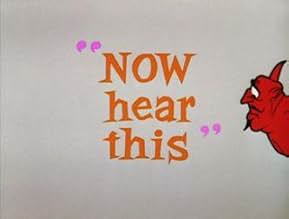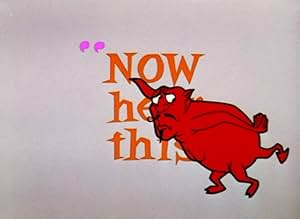Aggiungi una trama nella tua linguaIn this very abstract cartoon, a hard-of-hearing old Britisher finds a red horn and uses it as a megaphone, unaware that it is really a lost horn from the Devil's forehead. The Britisher fin... Leggi tuttoIn this very abstract cartoon, a hard-of-hearing old Britisher finds a red horn and uses it as a megaphone, unaware that it is really a lost horn from the Devil's forehead. The Britisher finds that the horn has the effect of amplifying every sound psychedelically and causing him ... Leggi tuttoIn this very abstract cartoon, a hard-of-hearing old Britisher finds a red horn and uses it as a megaphone, unaware that it is really a lost horn from the Devil's forehead. The Britisher finds that the horn has the effect of amplifying every sound psychedelically and causing him serious bodily harm.
- Regia
- Sceneggiatura
- Star
- Candidato a 1 Oscar
- 1 candidatura in totale
- Vocal effects
- (voce)
- (non citato nei titoli originali)
Recensioni in evidenza
What's the point of the cartoon? Why ask? This cartoon has as its purpose total abstraction, and it achieves that. "Now Hear This" certainly deserved its Oscar nomination (too bad that Chuck didn't win more during his lifetime). As the cartoon's not readily available on video or DVD, you can watch it on YouTube.
As other reviewers have described this, it involves three characters: the Devil, an elderly, British man in green, and a shorter man in purple and wearing a pointy hat. The Devil loses one of his horns and goes searching for it, the British man finds the horn which he mistakes for a megaphone or hearing aid, and the shorter man shows up again, and again randomly. Every time the Brit uses the horn, some thing happens that he wasn't expecting, not just with the various sounds that come out of it, but also with the various things that happen to him. Following all of those mishaps he suffers thanks to the extraordinary object, he's had enough as it caused him an abundance of trouble and disposes it. Since it's been nothing about a nuisance to him, he prefers to use his green, horn-shaped hearing aid instead, he gets that back, and as he does so, the British national anthem is played, and he's pleased with this. The Devil would eventually find his horn and put it back in place.
This is among the LT and MM shorts I remember well watching in my childhood. It genuinely is one of the oddest by Warners or otherwise ever made. One of the most different too, but it's good. It's one of the better LT and MM of the '60s, especially from the former half of that decade, when the old studio's cartoons were still considered to be high and at their best. This peculiar 'toon may not be for everyone, but I'm one of those who can handle it. All the characters in this are still interesting in the way of carrying out their actions rather than relying on and using dialogue. The actions clearly are what say it all and that's all we need, despite the plot being seemingly thin and senseless. The background scenes are mostly white, with the colors being on only the characters and the objects. Both sound effects and music are played well. The animation may be limited, but somehow it, like UPA, actually outdoes that of the Hanna-Barbera and Filmation studios' cartoons of the late '50s, '60s and '70s. I haven't gotten all that much into avant-garde music, although I've been more specifically into the avant-rock of bands like Tin Huey and one of its influences, Roxy Music. But for me it all depends, some of that I can take, others not so much. As especially some certain avant-garde music can be bad, especially if any of y'all who may be reading this fall asleep to it, it may cause nightmares. This is another grasping, experimental short directed by the late Chuck Jones, but I think I like his other directed WB cartoon short, High Note, even more, out of the two if I were to chose. Nonetheless, recommended, for those who are looking to step out of the normal zone and into the abnormal. Abnormal and abstract are just exactly what they are about it.
While Chuck Jones was no stranger to experimentation (Just see Duck Amuck!), this is a considerable departure from his previous work, not only due its semi-abstract visuals (Though Jones's signature art style remains perfectly recognizable, especially in the demon's design), but also because of its dry, surreal sense of humor, feelling closer to the minimalistic films by UPA rather than Looney Tunes.
I guess such unusual approach might be the reason of its obscure status, though there is an undeniable cleverness displayed here, featuring a rather stylish aesthetic despite the limited animation.
No, it's definitely not Jones's best work, nor his funniest, but it's very interesting nonetheless.
Without a doubt, a product of its time (a difficult time, by the way, for Warner Bros animation) with a refined charm that will certainly appeal more to adult audiences (specially animation historians) than children.
What impressed me so much about Now Hear This was how much material it fitted in such a short running time. The cartoon is just six and a half minutes or so, yet it has so many funny moments both visually and sound effects wise especially with the egg. This is all helped by the snappy pacing, Now Hear This does go very quickly without feeling rushed and there is never a dull moment.
The story of Now Hear This is a simple one, yet in its structure it is wonderfully abstract too. It wasn't just the material and pace that impressed me, the animation is wonderful with a great colourful stylistic look to it and very minimalist in style. The colours are audacious, the backgrounds are interesting and the characters are typical Jones in their design and when I say that I mean that in a good way.
The music is energetic and breezy, with the use of Mendelssohn's Spring Song never becoming annoying, a fun rendition of Yankee Doodle and a fun if bizarre variation of the Looney Tunes theme song. There are the sound effects as well, it isn't just the sound effects that make Now Hear This work, there are some truly great and creative sound effects and not one of them feel misplaced. Apart from one word, Quiet!, there is no dialogue, but that isn't a flaw in any way as it is the visuals and sound that drives Now Hear This.
All in all, a Chuck Jones masterpiece. 10/10 Bethany Cox
Lo sapevi?
- QuizThis was the first Warner Bros cartoon to use the "modern" Looney Tunes opening and closing sequence featuring stylized animation, an abstract WB logo, zooming "OO" in the word "Cartoon", swirling zooming lines (in place of the zooming shield), and slick lettering, on a black background, all to a "modern" rendition of the Looney Tunes theme ("The Merry-Go-Round Broke Down"). This title will also be used on four 1964 shorts ("Bartholomew Vs. The Wheel," "Senorella and the Glass Huarache," "Pancho's Hideaway" and "Road to Andalay,) and then every WB cartoon from 1965 to 1969.
- Citazioni
[the only spoken line]
Voice: QUIET!
I più visti
Dettagli
- Tempo di esecuzione6 minuti
- Mix di suoni
- Proporzioni
- 1.37 : 1
Contribuisci a questa pagina

















